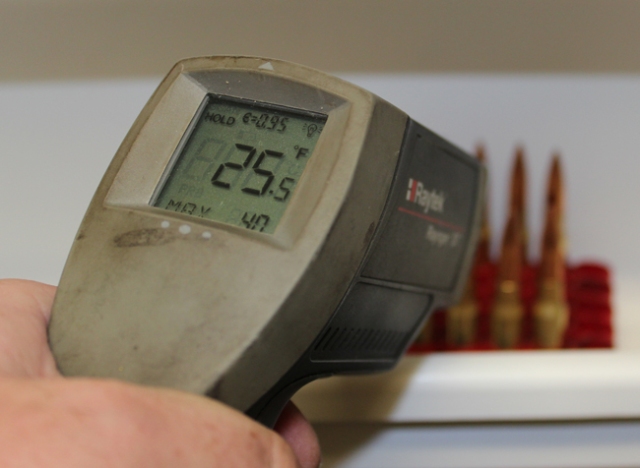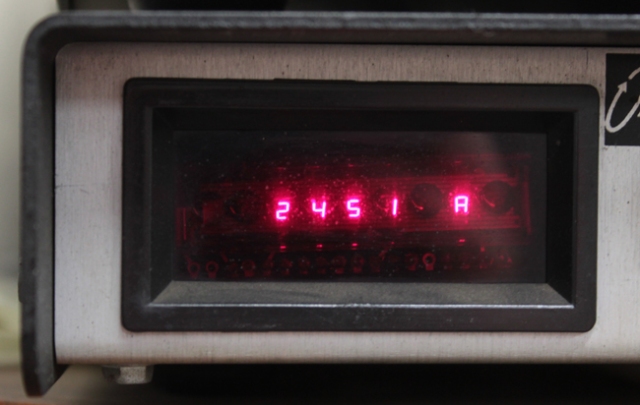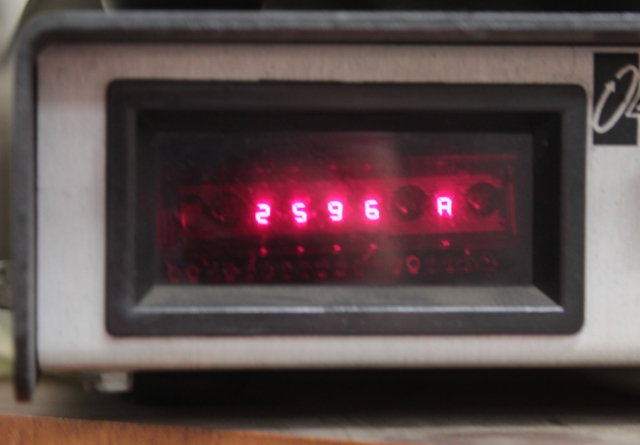
Sierra Bullets are some of the most accurate bullets available today.
Recently, Sierra Bullets put out an informational publication concerning the topic of temperature effects on bullet trajectory. This topic has been in the mainstream lexicon of precision shooters, hunters, and target shooters for decades. Opinions on the matter range from temperature doesn’t affect bullet flight enough to worry about it, to others claiming a new zero must be obtained for every 20-degree variance in the outside temperature. This post, written by Sierra Bullet’s Chief Ballistician Tommy Todd, is not only informative on the issue, but rather remarkable for its findings.
Sierra Bullets, located in Sedalia, Missouri, is one of the world’s foremost leaders in bullet and cartridge manufacturing. Their Federal Gold Medal Match cartridge, using the Sierra 168-grain BTHP bullet, has been the chosen round by F.B.I. snipers for many years.
EDITOR’S NOTE: This article is re-published from the Sierra Bullets Blog with the express permission of Sierra Bullets. Though BlueSheepDog Staff were not present during the testing, we are very familiar with Sierra Bullets products and performance. Aaron is currently a Sniper Team Leader for his agency’s SWAT Team, and has been using Federal Gold Medal Match ammunition, with the Sierra 168-grain BTHP bullet, for over 8 years.
Aaron can absolutely attest to the accuracy, consistency, and quality of manufacturing of Sierra bullets, and we feel very confident the information contained in this article can be taken as the “gospel truth” concerning ballistic performance of the rounds at the temperatures tested.
In addition, we feel confident that further general knowledge can be gleaned from this test for most commercially available precision rifle ammunition. Sierra Bullets chose their 175-grain Match King BTHP bullets for this test, and the test was conducted in Sierra’s underground range for consistent conditions.
Written by Chief Ballistician Tommy Todd
 A few weeks ago I was attending the Missouri State F-Class Match, this was a two-day event during the summer and temperatures were hot one day and hotter the next. I shot next to a gentleman that was relatively new to the sport. He was shooting a basically factory rifle and was enjoying himself with the exception that his scores were not as good as he hoped they would be and he was experiencing pressure issues with his ammunition. I noticed that he was having to force the bolt open on a couple of rounds. During a break, I visited with him and offered a couple of suggestions which helped his situation somewhat and he was able to finish the match without major issues.
A few weeks ago I was attending the Missouri State F-Class Match, this was a two-day event during the summer and temperatures were hot one day and hotter the next. I shot next to a gentleman that was relatively new to the sport. He was shooting a basically factory rifle and was enjoying himself with the exception that his scores were not as good as he hoped they would be and he was experiencing pressure issues with his ammunition. I noticed that he was having to force the bolt open on a couple of rounds. During a break, I visited with him and offered a couple of suggestions which helped his situation somewhat and he was able to finish the match without major issues.
He was shooting factory ammunition, which is normally loaded to upper levels of allowable pressures. While this ammunition showed no problems during “normal” testing, it was definitely showing issues during a 20 round string of fire in the temperatures we were competing in. My first suggestion was that he keep his ammunition out of the direct sun and shade it as much as possible. My second suggestion was to not close the bolt on a cartridge until he was ready to fire. He had his ammo in the direct sunlight and was chambering a round while waiting on the target to be pulled and scored which can take from a few seconds to almost a minute sometimes. This time frame allowed the bullet and powder to absorb chamber temperature and build pressure/velocity above normal conditions. Making my recommended changes lowered the pressures enough for the rifle and cartridge to function normally.
After thinking about this situation, I decided to perform a test in the 308 Winchester cartridge. This load is not at the maximum for this cartridge, but it gives consistent velocities and accuracy for testing.
I took ten of the cartridges and placed them in a freezer to condition.

 I set ten of them on my loading bench, and since it was cool and cloudy the day I performed this test I utilized a floodlight and stand to simulate ammunition being heated in the sun.
I set ten of them on my loading bench, and since it was cool and cloudy the day I performed this test I utilized a floodlight and stand to simulate ammunition being heated in the sun.
 I kept track of the temperatures of the three ammunition samples with a [easyazon_link identifier=”B00EMOKB3Q” locale=”US” tag=”bluesheecom-20″]laser non-touch thermometer[/easyazon_link].
I kept track of the temperatures of the three ammunition samples with a [easyazon_link identifier=”B00EMOKB3Q” locale=”US” tag=”bluesheecom-20″]laser non-touch thermometer[/easyazon_link].
The rifle was fired at room temperature (70 degrees) with all three sets of ammunition.
I fired this test at 200 yards out of a [easyazon_link identifier=”B001O00XCA” locale=”US” tag=”bluesheecom-20″]return-to-battery machine rest[/easyazon_link]. The aiming point was a leveled line drawn on a sheet of paper. I fired one group with the scope aimed at the line and then moved the aiming point across the paper from left to right for the subsequent groups.
Please notice that the velocity increased as the temperature of the ammunition did.
EDITOR’S NOTE: It appears Sierra used an Oehler Model 33 chronograph.
The ammunition from the freezer shot at 2451 fps.

The room temperature ammunition shot at 2500 fps.
 The heated ammunition shot at 2596 fps.
The heated ammunition shot at 2596 fps.


The tune window of the particular rifle is fairly wide as is shown by the accuracy of the three pressure/velocity levels and good accuracy was achieved across the board. However, notice the point of impact shift with the third group? There is enough shift at 200 yards to cause a miss if you were shooting a target or animal at longer ranges. While the pressure and velocities changed this load was far enough from maximum that perceived over pressure issues such as flattened primer, ejector marks on the case head, or sticky extraction did not appear. If you load to maximum and then subject your ammunition to this test your results will probably be magnified in comparison.
 This test showed that pressures, velocities, and point-of-impact can be affected by temperatures of your ammunition at the time of firing. It’s really not a bad idea to test in the conditions that you plan on utilizing the ammo/firearm in if at all possible. It wouldn’t be a bad idea to also test to see what condition changes do to your particular gun and ammunition combination so that you can make allowances as needed. Any personal testing along these lines should be done with caution as some powder and cartridge combination could become unsafe with relatively small changes in conditions.
This test showed that pressures, velocities, and point-of-impact can be affected by temperatures of your ammunition at the time of firing. It’s really not a bad idea to test in the conditions that you plan on utilizing the ammo/firearm in if at all possible. It wouldn’t be a bad idea to also test to see what condition changes do to your particular gun and ammunition combination so that you can make allowances as needed. Any personal testing along these lines should be done with caution as some powder and cartridge combination could become unsafe with relatively small changes in conditions.
Final Thoughts
As a life-long shooter, hunter, 20-year police officer, and 8-year sniper, I find the information from this testing extremely valuable. Understanding the intricacies of bullet travel has become a passion of mine. As a hunter I want to be as ethical and humane in the harvesting of an animal as possible. As a police sniper I am intimately aware of the difference fractions of an inch can have. And shooting tight groups is just a very nice feeling.
Of particular interest to me from this test was the overall lack of trajectory influence when the cartridges were frozen. Though there is a slight change of point of impact from frozen to room temperature, the difference is negligible when considering these groups were achieved at 200 yards. The difference between the groupings point of impact is only around a quarter-MOA! Those type of results are within the human error factor, or in other words, the only real change in point of impact could just as easily be attributed to shooter input rather than bullet trajectory.
When the heated rounds are fired (leaving the barrel at nearly 100 fps faster than room temperature), we finally see a noticeable change in point of impact. Even then the difference in groupings from room temperature to heated is only about half-MOA! The groupings are around one-inch different, but at 200 yards the difference only equates to 1/2 MOA.
The heated rounds, leaving the muzzle faster, impacted lower than the room temperature and frozen rounds. Considering the zero was established at 200-yards for this test, the results tell me the “hotter” rounds have a flatter trajectory. This flatter trajectory causes the bullet to not raise to the established zero by 200-yards, but they are still below zero and on the rise because of the flatter trajectory caused by the heated and faster travel.
This kind of information is extremely valuable to a shooter who may be exposed to extreme temperatures for hours before being called upon to shoot. As a police sniper it confirms our practice of being especially cautious about where rounds are stored, ensuring they are as guarded from sunlight or heat sources as possible.
In a critical moment, when a precision shot needs to be made, the police sniper cannot be troubled about what the round may do because of excessive heat. Doubts lead to error, and an error in a police involved shooting could be disastrous. The suspect may not be incapacitated, resulting in further violence, or the hostage may be struck resulting in injury or death to an innocent person.
Police snipers, particularly, should take note of these testing results. More confidence can be obtained in cooler conditions up to spring time temperatures. However, when the temperatures soar, police snipers must take special precautions to cover rounds from exposure to the sun or heat sources.
In addition, on long call-outs in high heat conditions, police snipers should strongly consider changing the ammunition in their rifles every hour or so, to prevent heat build up. This procedure can be done in a couple of seconds with detachable magazines (something BlueSheepDog recommends), but will have to be coordinated among the sniper team if a sniper has to unload and re-load an internal magazine.